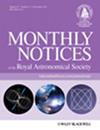射电静止类星体中与流相关的射电发射
IF 4.7
3区 物理与天体物理
Q1 ASTRONOMY & ASTROPHYSICS
引用次数: 0
摘要
在这项工作中,我们利用从斯隆数字巡天(SDSS)第 16 版数据中选取的大量 I 类类星体样本(∼37,000),重新研究了[O III]线宽 w90(作为 AGN 流出速度的指标)与 RQQs 中的射电辐射之间的关系。通过对卡尔-詹斯基(Karl G. Jansky)甚大阵(VLA)巡天(VLASS)的射电图像进行中值叠加(以包括个别未探测到射电的RQQs的主要部分),我们的研究表明,在我们的SDSS RQQs中,w90和射电辐射之间的相关性是显著的,并且在控制了黑洞质量、类星体光度、爱丁顿比和红移的影响之后仍然是稳固的。这种内在联系证明,类星体中的[O III]外流很可能是由吸积盘发射的广角亚相对论类星体风造成的,可能对一般 RQQs 中的射电辐射做出了主要贡献。另外,如果RQQs中的低功率喷流无处不在,并能通过与ISM的相互作用有效地增强[O III]宽度,那么这种相关性也可能归因于RQQs中的低功率喷流。同时,在控制了黑洞质量、类星体光度、爱丁顿比和红移的影响之后,[Ne V]/[O II]发射线的通量比所追踪的恒星形成率与 w90 没有关系。这表明,w90 越大的 RQQs 射电发射越强,并不能归因于宿主中外流增强(正反馈)的恒星形成。不过,这也表明外流虽然与射电功率有很强的相关性,但对其宿主的恒星形成既没有产生正反馈,也没有产生负反馈。本文章由计算机程序翻译,如有差异,请以英文原文为准。
Outflow-related radio emission in radio-quiet quasars
In this work, we revisit the relationship between [O III] line width w90 (as the indicator of AGN outflow velocity) and the radio emission in RQQs by employing a large sample of Type I quasars (∼37, 000) selected from the Sloan Digital Sky Survey (SDSS) Data Release Sixteen. By median stacking the radio images (to include the dominant fraction of individually radio non-detected RQQs) of Karl G. Jansky Very Large Array (VLA) Sky Survey (VLASS) for subsamples of RQQs with different w90, our study demonstrates that, the correlation between w90 and radio emission in our SDSS RQQs is significant, and remains solid after controlling the effects of black hole mass, quasar luminosity, Eddington ratio and redshift. This intrinsic link supports that the [O III] outflows in quasars, most likely resulted from wide-angled sub-relativistic quasar winds launched from the accretion disc, could make a dominant contribution to radio emission in the general RQQs. Alternatively, the correlation may be attributed to low-power jets in RQQs if they are ubiquitous and could efficiently enhance the [O III] width through interacting with the ISM. Meanwhile, the star-formation rates traced by the flux ratio of [Ne V]/[O II] emission lines display no dependence on w90 after controlling the effects of black hole mass, quasar luminosity, Eddington ratio and redshift. This suggests that the stronger radio emission in RQQs with larger w90 could not be attributed to outflow enhanced (positive feedback) star formation in the hosts. However, this also indicates the outflows, though exhibiting robust correlation with radio power, produce neither positive nor negative feedback to the star formation in their hosts.
求助全文
通过发布文献求助,成功后即可免费获取论文全文。
去求助
来源期刊

Monthly Notices of the Royal Astronomical Society
ASTRONOMY & ASTROPHYSICS-
CiteScore
9.10
自引率
37.50%
发文量
3198
审稿时长
3 months
期刊介绍:
Monthly Notices of the Royal Astronomical Society is one of the world''s leading primary research journals in astronomy and astrophysics, as well as one of the longest established. It publishes the results of original research in positional and dynamical astronomy, astrophysics, radio astronomy, cosmology, space research and the design of astronomical instruments.
 求助内容:
求助内容: 应助结果提醒方式:
应助结果提醒方式:


